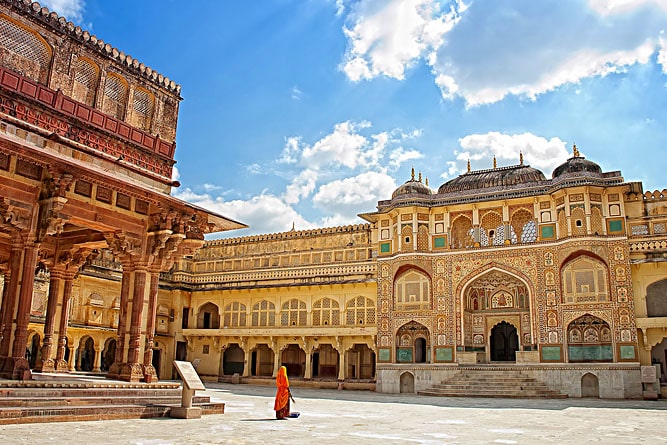Golden Triangle
Tourist circuit: Delhi-Agra-Jaipur
must-see attraction
Visit duration: People typically spend 5 to 7 days to cover the Golden Triangle itinerary
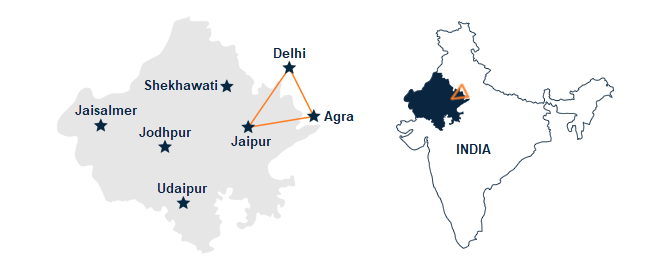
About the Golden Triangle
The Golden Triangle of India is the most visited travel itinerary in Northern India. The Golden Triangle tour takes 5 to 7 days. If you have more time, you could also visit other parts of Rajasthan.
The tourist attraction forms the shape of a triangle due to the locations of the cities comprising Delhi, Agra and Jaipur.
The Golden Triangle is about 720 km by road with each city just about 4 to 5 hours of drive. The triangle contrasts grandeur mosques, serene temples and chaotic-crowded bazaars. It houses one of the seven wonders of the world, the Taj Mahal along with several UNESCO acclaimed world heritage sites.
1. Delhi
Delhi is located on the northern side of the Golden Triangle. The historical complexes preserve the rich legacies of art and culture of the bygone eras and chronicle the diverse dynasties that reigned this royal city through its architecture. The city served as a major citadel for many rulers throughout history.
The city is the conglomeration of the old and the new, from the oldest historic structure such as the Qutub Minar to the streets of Chandni Chowk, the ancient and modern India meet in the commercial region of Connaught Place.
- Qutub Minar or the victory tower is the earliest Indo-Islamic structure built in India. Qutb-Ud-Din Aibak commenced the construction of the minaret at the end of the 12th century.
- Lotus Temple is a Bahari House of Worship that was constructed in the modern era. The temple is renowned throughout the world and has won numerous awards for its architectural layout.
- Red Fort is the primary 'Lal Quila' and was the residence of the Mughals after emperor Shah Jahan shifted the capital to Delhi.
- Humayun’s Tomb is the mausoleum that not only holds the grave of the emperor Humayun but also comprises the graves of the royal members from the Mughal era. The enormous presence of the mausoleum portrays the majesty of the Mughal dynasty.
- Jama Masjid is one of the largest mosques in India. It is a congregational mosque built by Shah Jahan in the mid-17th century.
- India Gate, also known as the All India War Memorial, pays tribute to the Indian soldiers that fought in the First World War. The gate was constructed by the British Raj in the first half of the 20th century.
- Chandni Chowk was built during the 17th century and is one of the oldest and most crowded wholesale markets in India. This moonlight square trading centre was designed by Shah Jahan's daughter, Jahanara.
- Jantar Mantar is an observatory that compiles astronomical tables and holds thirteen architectural astronomical instruments which were built by Maharaja Jai Singh of Jaipur in the 18th century.
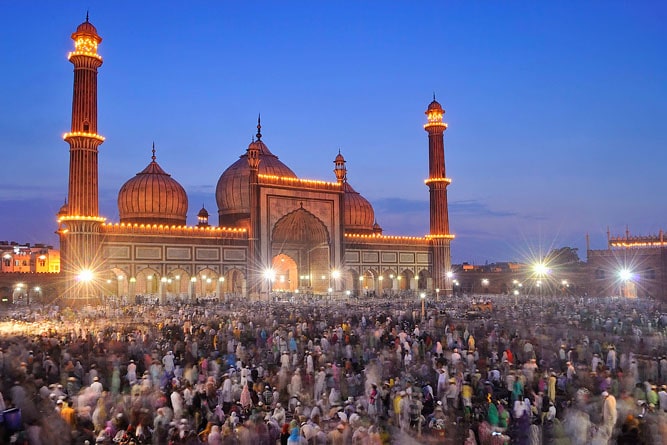
2. Agra
Agra is settled on the eastern side of the Golden Triangle and was founded by Sikandar Lodi of the Delhi Sultanate in 1504. The city was earlier known as Akbarabād. The grandeur legacy of the Mughal era is retained through the notable Indo-Islamic architecture in this city. The paramount craftsmanship carved from white marble stone with stucco and inlay method to ornate the monument with precious jewels can be witnessed in this Agra.
- Taj Mahal was constructed by the Mughal Emperor Shah Jahan in memory of his wife Mumtaz Mahal in the 17th century.
- Tomb of Itimad-Ud-Daulah is a mausoleum which was constructed by Nur Jahan as a memorial for her parents Mirza Ghiyas Beg and Asmat Begum in the 17th century.
- Agra Fort, also known as the 'Lal Quila' of Agra, was the primary residence of the Mughal family back in the 16th century. Akbar renovated this existing complex during the Mughal era in the mid-16th century.
- Mehtab Bagh, meaning the moonlight garden, is a Charbagh built by the first Mughal emperor, Babur in the 16th century.
- Fatehpur Sikri is one of the oldest towns in India that still holds its ancient structure in contemporary times. It was also an outcome of the Mughal Period.
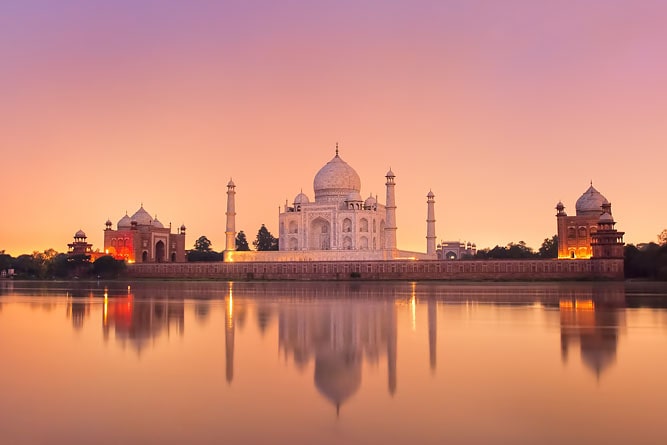
3. Jaipur
Jaipur, also known as the pink city, is situated on the western side of the Golden Triangle. Despite its arid climate, the vibrant and colourful culture of the city never ceases to amaze the visitors. Jai Singh II of the Kachhwaha Rajput founded the city in 1727.
The city was the land of the Rajput rulers that held its cultural heritage through its majestic ancestry hotels along with historical monuments and gardens. The famous Hawa Mahal resides in this pink city. The fabric of the city is renowned for its classic crafts and designs.
- Hawa Mahal was built with red and pink sandstones in 1799 by Pratap Singh, the grandson of the founder of the city. Khetri Mahal influenced the architecture of the palace.
- City Palace is as old as the city itself. The palace was the residence of the Jaipur royal family and was also the centre of art, religious and cultural events.
- Amber Fort, renowned for its artistic style and element, was originally built by Raja Man Singh and was later renovated by Jai Singh II. The fort belongs to the ancient realm of architecture dating back to the 10th century.
- Jantar Mantar is another observatory constructed by Jai Singh II that holds nineteen astronomical instruments. It was the primary observatory used by the king.
- Nahargarh Fort was built as a retreat to strengthen the defence by Jai Singh II in the early 18th century and is situated on the edge of the Aravalli Hills.
- Albert Hall Museum is the oldest museum that is exemplary of Indo-Saracenic architecture. It is a hundred-year-old museum that is named after King Edward VII.
- Galtaji or the Monkey Temple is an ancient Hindu pilgrimage that is encircled by hills and water bodies. The Vaisanans have visited this pilgrimage since the early 15th century.
- Jal Mahal is a palace settled in the middle of Man Sagar Lake which was constructed in 1699. The palace portrays Rajasthani architecture of the royal past.
- Jaigarh Fort or the Cheel ka Teela was developed to protect Amber Fort in the first half of the 18th century by Jai Singh II.
- Birla Mandir is a Hindu temple that is just two decades old and was built by B.M Birla Foundation. The temple is dedicated to God Vishnu and Goddess Laxmi.
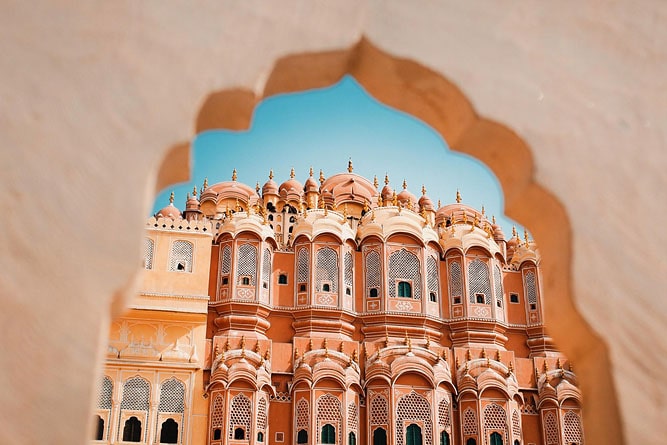
Facts and tips about the Golden Triangle
- The Taj Mahal stays closed on Fridays and the Lotus Temple stays closed on Mondays.
- Mathura, the birthplace of Krishna, can also be visited during the tour of the Golden Triangle.
- The Taj Mahal can be viewed from the Mehtab Bagh. So if the crowd is overwhelming for you then you can enjoy the sight of the mausoleum from the park.
Map of India's Golden Triangle
FAQs about the Golden Triangle
1. How much time is required to tour the Golden Triangle?
A week is enough to complete the tour of the Golden Triangle but if you want you can stay as per your choice.
2. Where can I escape the crowd while travelling the Golden Triangle?
The Golden Triangle of India is always overwhelmed with tourists, but the best way to escape the crowd will be to visit the places early in the morning.
3. How can I avoid Delhi belly?
Not everyone gets sick while visiting the Golden Triangle of India, but through simple ways, you can avoid the “Delhi belly”. You can buy a mineral water bottle, with a sealed lid, from reputed companies.
